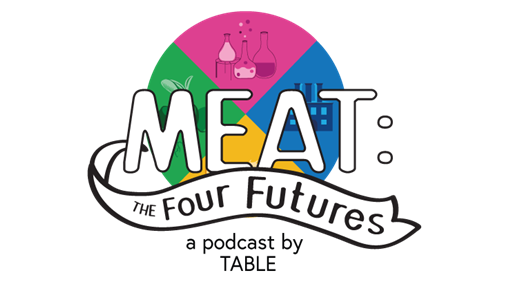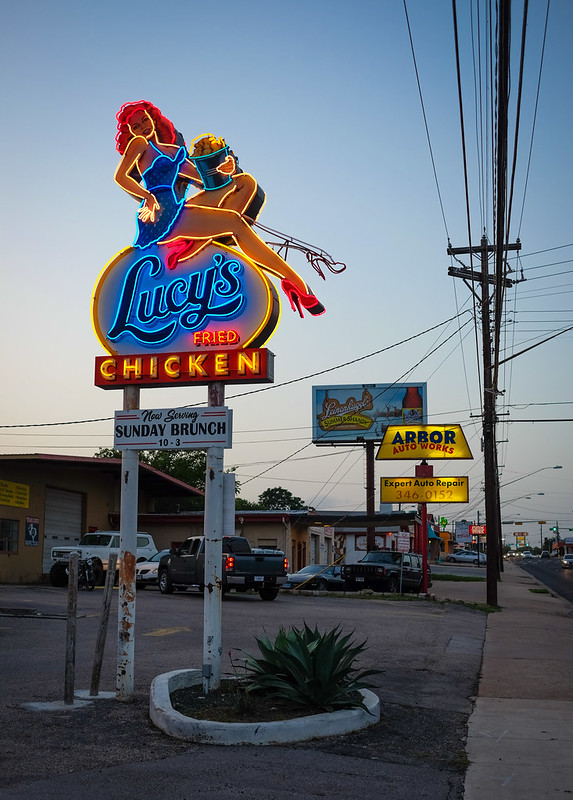In a piece originally published by the Feminist Food Journal, Tamsin Blaxter uses a feminist lens to examine how gender shapes the ways in which we interpret and project certain futures for meat.
The Feminist Food Journal (FFJ) is an online publication that explores food and culture through an intersectional and global feminist lens.
An audio version of this essay will be available from FFJ shortly. The FEED Podcast is also producing an episode in collaboration with FFJ, due out later this year.

In a world of climate crisis, disappearing species, deepening inequality and rising malnutrition, can meat only be part of the problem — or is it also a potential solution?
Last year, our team at TABLE spoke to farmers, tech investors, food scientists, nutritionists, sociologists and more to try to answer these questions. Our eight-part podcast series, Meat: the Four Futures, painted and peered into their visions in the ever more acrimonious debate over the future of meat eating. Broadly, we identified four different views of the way forward:
- Efficient Meat 2.0. In this vision, we’re already on the right track. The world population is growing and people need and enjoy meat. We need to keep making animal agriculture bigger to solve the decades-long crisis of global malnutrition, while making it cleaner and more efficient to address its environmental impacts.
- Less Meat. Here, we shift away from the industrial farming model of the 20th century. We farm far fewer animals but in more natural settings, to the benefit of animals, people, and the planet.
- No Meat. This puts the suffering and killing of non-human animals at the centre of the conversation. Proponents point out that we can live healthy, happy lives on just plant-based foods, which are a far more efficient use of resources in any case.
- Alternative “Meat”. Proponents of this one think we’ll never persuade everyone to stop eating meat. In this future, we stop farming animals because we’ve learnt to make meat in factories and labs—with near-perfect efficiency and no suffering involved.
Each of these futures is persuasive to someone. The strength of their scientific claims might vary, but each is a story that voices particular values and aspirations. Each one has its backers.
Analyzing them through a feminist lens can show us quite a lot about why. Why is meat so rich in symbols, so easily connected with deep-rooted beliefs about what is good and bad in the world? How can two people from the same community who share many of the same influences find they have instincts so utterly in conflict in this space? We didn’t get the chance to fully unpack the gendered dimensions of these futures on our podcast — but doing so offers insights on potential opportunities and challenges with any path taken.
As part of the Meat: The Four Futures podcast, we created a quiz asking if your values match your diet. You can take the quiz here.
Less and No Meat: A gendered and colonial divide
One deep dividing line between the different meat futures concerns views on animal suffering. The histories of feminism and animal liberation are deeply intertwined, as we see when we look at the origins of modern secular vegetarianism and its relationship with the women’s suffrage movement in the 19th century.1
One scholar who advanced our understanding of the link between the suffering of women under patriarchy and that of non-human animals under speciesism is, of course, Carol J. Adams, whose book The Sexual Politics of Meat remains an influential text three decades after its publication. For Adams, the consumption of non-human animals and the sexual domination of women each stands as a reinforcing analogue of the other. Female bodies and animal bodies are both depersonalized, with the “referent” — the experiencing self — removed, and desire focused on disembodied body parts — breast, leg, and back. Adams notes how the metaphor of meat-eating is often used to describe male sexual desire and violence and the metaphor of meat to describe sexualized bodies. Meat, in turn, is often advertised with sexual imagery.2
In this cultural context, it is unsurprising that the argument that we should consider human violence towards animals as ethically similar to violence towards other humans lands very differently for different people. (The TABLE blog Use, Misuse and Abuse - a vet reflects on animal exploitation further explores the links between domestic violence and violence towards animals.)
But for some thinkers, the social liberation movements of the last two centuries — feminism, racial justice, socialism, queer liberation, animal liberation — all share a fundamental argument: we should grow our definition of who counts. Whose perspective matters? Whose suffering matters? All these movements ask us to expand our circle of care. Yet the concept of care itself is gendered as feminine in our cultural discourse, making arguments based on an ethic of care potentially threatening to masculine identity. This has consequences for the discussion of animal suffering and meat eating. In one study, psychologist Carolyn Semmelor divided 230 participants into two groups to observe reactions to learning more about a lamb dish. While one group received information about meat quality, nutrition and health, the other learned about the lambs' upbringing and slaughter. Women's perceptions of the lamb dish worsened after connecting it to the once-living animals. However, men's reactions varied, with some growing defensive and even doubling down on their “meat identity” by vowing to eat more meat.
A consequence of this is that women are more likely to be engaged in animal activism and more likely to be vegetarian or vegan than men — i.e. women are more likely to be convinced by the arguments of the No Meat future. Yet the connection between masculinity and meat goes far beyond the gendering of care or consideration of animal subjectivity. It has deep historical roots and is bound up in the history of colonialism.
We find recurring entanglements between masculinity and meat-eating again and again in the history of European literature. Men in ancient Greece got preferential shares of meat from, and special roles in, ritual slaughter throughout much of the year in Ancient Greece. In what we now know as the UK, male Anglo-Saxon slaves received more meat than female slaves. The ability to hunt and kill was seen as a symbol of the right to rule among French nobles in the court of Charlemagne. Even in Shakespeare, we see extensive symbolic connections between meat-eating and masculinity, where the shrew is tamed partly by being starved of meat.
These links are made on the backdrop of an even more consistent cultural pattern: the idea that meat is the food of the wealthy and powerful. This association was particularly strong in 19th-century Europe. To early nutritionists, meat was the ideal source of sustenance, flesh made food in order to make flesh anew. It was inevitable and right that it be the most valuable foodstuff and so, eaten by the wealthiest. Meat was the dish of power and the upper classes.
Accordingly, one reason you might want to emigrate to the colonies was the promise of greater space, freedom and wealth — partly in the form of regular meat-eating. Countries like the US, Argentina, and Australia achieved extremely high levels of popular meat consumption far earlier than European countries. Farming animals for meat in settler-colonial states was a key justifier of stealing land from Indigenous populations. Meat-eating also became a symbol of whiteness, an explanation for the success of European powers in dominating the world, a way of dividing other cultures into meat-eating “noble savages” (fetishized for their virility even while they were vilified for every other reason) and simply “backward tribes”.3

A Burger King ad for a beef sandwich.
They feel regressive, but most of these connotative links have survived into our culture today. We can see them expressed in anti-veganism, alt-right dietary discourse and fad diets like the carnivore diet. Online right-wing provocateurs dub their enemies “soyboys” in reference to racist-sexist ideas about non-meat consumption, Asian people and effeminacy; they use the slogan ‘Heil milk’ to invoke the claim that diet explains the domination of the world by colonial powers.4 In the largely male and very online world of fad diets, pseudoscientific claims come into contact with male supremacist conspiracy theories about exposure to estrogen through elements of modern lifestyles. The resulting discourse implores men to reclaim a ‘natural’ dominating masculinity by consuming more (or only) meat, through paleo or “carnivore” diets.5 Such examples may be extreme, but they are simply exaggerated versions of messages propagated through everyday advertising, entertainment and politics.
With all this context, it should be no surprise that different people have sharply differing intuitions on the ethics of killing and consuming animals and that gendered factors play into these viewpoints.6

You can listen to all 9 episodes of the Meat: The Four Futures podcast here.
Efficient Meat 2.0 and the Alternative “Meat”: the techno-futures
The role of technology is another deep split in the different meat futures, and here too feminism can illuminate important elements of the debate we might otherwise miss. The Efficient Meat 2.0 and the Alternative “Meat” futures put great faith in technology to give us more of what we want and need with less labour and less harm to the world. Much has been written on the gendered nature of food labour — women do most food preparation at home and make up most of the workforce in the food sector.7 (This is despite the fact that the role of the ‘farmer’ is still strongly coded as male.) Much has also been written on the emancipatory power of home technologies: women, it is often imagined, were liberated as much by the washing machine and the dishwasher as by activism and protest.8 So are these technological meat futures feminist futures?
Broadly, the consensus seems to be “no”, or at least “it’s complicated”. But one thing that has been absent from our discussion so far is a view of nature. Instead of seeing the split between our scenarios as one about attitudes to technology, we could instead frame it as being a split in attitudes to nature: proponents of Less Meat tend to advocate more “natural” (extensive, low-density, agroecological, regenerative) farming systems. On the other hand, supporters of Efficient Meat 2.0 are more interested in the purported “naturalness” of human meat consumption. Scholars often divide views on nature into two broad categories: the Romantic/pastoral/agrarian and the industrial/rational/Darwinian. A Romantic view of food and nature might lead one towards pro-animal positions but also “pro-natural” (however loosely defined) positions. An industrial view might instead view nature in terms of competition for resources, the conquest of amoral, harmful forces by human progress.
These views of nature, too, are tangled up with gender. Although food labour might be coded as “women’s work”, boardrooms and other positions of power in the food industry are still disproportionately occupied by men. Technological visions of the future generally require a lot of capital: they are visions in which big companies save the world and make a lot of money along the way. If feminism is a philosophy of equality and ending domination, strategies that require strengthening corporate power are at best uncomfortable. Additionally, it is interesting to note that in the much-hyped, sci-fi world of cultured meat, most of the prominent investors and CEOs are men. One exception to this is Isha Datar, a well-known face in the alt-meat room and a pioneer of cellular agriculture (she, in fact, coined the term). Datar is the executive director of New Harvest, a research institute funding a more democratic vision of these technologies, in which they are developed and held in public hands. This type of justice-minded ethos, however, remains a minority in the field.

A roadside neon sign outside Austin, Texas for "Lucy's Fried Chicken" featuring a woman in a dress and high heels clutching a tub of fried chicken. Photo by Lars Plougmann via Flickr.
Thinking through a way forward
We’ve spent a lot of words here on meat, what it means and where it comes from — but not as many on the needs it is eaten to satisfy. Meat — or animal source food generally — is argued by many to be the most convenient package with which to address problems of food poverty, mal- and under-nutrition, since it is both calorie-dense and rich in a wide range of micronutrients. This dietary multifunctionality makes animal-source foods an appealing solution when facing complex nutritional needs across a food-insecure population.
It’s true that the global burden of malnutrition is immense. Menstruating people and children, two groups with higher micronutrient needs and yet typically lower consumption of animal-source foods, suffer especially. Here, then, we find a convincing feminist critique of how meat is currently distributed, both between countries and within populations. And we might see a just way forward: decreasing meat consumption in wealthy countries where emissions are high and problems of under-nutrition are rare, while increasing per-capita consumption in the Majority World.9
Squaring this neat solution with environmental pressures, concerns for animal suffering, and cultural contexts is more difficult. It’s worth reiterating that the acts of producing and eating any food tend to be deeply embedded in culture. A cow might be a store of family wealth, a symbol of prestige, or a religious icon, in addition to being a source of calories and micronutrients and a living, feeling being. Visions for the future that pivot around a handful of numbers tend to flounder when they encounter the complexity of the human world.
All four visions of the future we explored in our series had gendered dimensions, and there is far more to say than we have space to write here. At TABLE, our conviction is that to move the food system towards a more sustainable place we need to understand both the meaning ascribed to food and farming, and the science. If you’re interested in learning more — about the scenarios, the arguments made for them and the people pushing for them, the science behind it all and whether it holds up — listen to Meat: the Four Futures.
Footnotes
- Leah Leneman, ‘The Awakened Instinct: Vegetarianism and the Women’s Suffrage Movement in Britain’, Women’s History Review 6, no. 2 (June 1997): 271–87, https://doi.org/10.1080/09612029700200144.
- See also https://www.youtube.com/watch?v=WlUvQkW4B1k&t=3s.
- We covered all of these topics at TABLE in our history of protein: Tamsin Blaxter and Tara Garnett, ‘Primed for Power: A Short Cultural History of Protein’ (TABLE, 2 November 2022), https://doi.org/10.56661/ba271ef5.
- Stănescu 2018. Note that the idea of a genetic-dietary explanation for the dominance of European colonial powers retains a scientific semi-legitimacy, recurring in mainstream discourse even in recent years. E.g. Cook, Justin. 2015. No use crying: The ability to digest milk may explain how Europe got rich. The Economist. https://economist.com/finance-and-economics/2015/03/28/no-use-crying. (5 June, 2024).
- Travis Hay and Jennifer Poudrier, ‘The Rise of the Carnivore Diet and the Fetishizing of Indigenous Foodways’, in Routledge Handbook of Critical Obesity Studies, ed. Michael Gard, Darren Powell, and José Tenorio (Milton Park, Abingdon, Oxon ; New York, NY: Routledge, 2022), 289–96.
- Although we have mentioned here the connections between meat and masculinity, power, wealth, and race in the context of wealthy Anglophone countries, these connections are by no means unique. Thinking of meat as “masculine food” or as “the food of the powerful” is common across cultures. These associations have undoubtedly been reinforced the world over by spreading Western dietary patterns and the influences of colonialism, neocolonialism and capitalism. But there is ample evidence too that they have independent existences and deep histories in many places.
- For readers interested to learn more, good introductory texts are: Koch, Shelley L. 2019. Gender and food: a critical look at the food system (The Gender Lens Series). Lanham, MD: Rowman & Littlefield; World Bank, Food and Agriculture Organization, & International Fund for Agricultural Development. 2008. Gender in Agriculture Sourcebook. The World Bank. https://doi.org/10.1596/978-0-8213-7587-7.
- See: Hester, Helen & Nick Srnicek. 2023. After work: a history of the home and the fight for free time. London ; New York: Verso: pp15-48; Wajcman, Judy. 1991. Feminism confronts technology. University Park, Pa: Pennsylvania State University Press; Dini, Rachele. 2022. “All-electric” narratives: time-saving appliances and domesticity in American literature, 1945-2020. New York: Bloomsbury Academic.
- E.g. the ‘Healthy’ scenario in: Mora, Olivier, Chantal Le Mouël, Marie De Lattre-Gasquet, Catherine Donnars, Patrice Dumas, Olivier Réchauchère, Thierry Brunelle, et al. 2020. Exploring the future of land use and food security: A new set of global scenarios. (Ed.) Elisabeth Bui. PLOS ONE 15(7). e0235597. https://doi.org/10.1371/journal.pone.0235597.












Post a new comment »